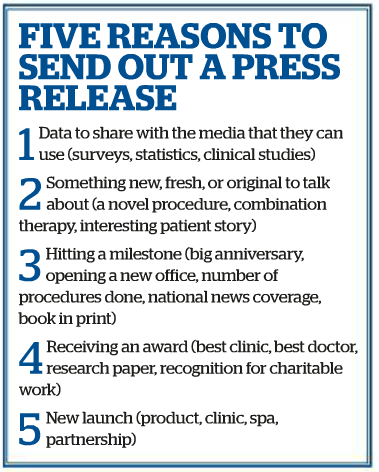With a world of information at our fingertips it can be difficult to stand-out from the crowd. Wendy Lewis explains how to create good releases that resonate with your target audience.
The purpose of a press release is to get your story in front of as many people as possible. By posting a press release to a newswire service, it will be sent out to thousands of publications in the designated markets, and ultimately reposted on other places online. The more journalists who view your press release, the more likely it will be picked up by other publications.
But today, journalists get literally hundreds of press releases every day. With this type of volume, one has to wonder how effective press releases are at actually generating media coverage?
The truth is that most press releases end up being deleted for several main reasons; targeting of press releases is generally sloppy so it doesn’t always get to the right person, or the release is not tailored to a specific audience rendering it basically irrelevant, or the release is not newsworthy enough to begin with. Other reasons why a press release doesn’t get picked up is that it is not formatted or written well, or no interesting sound bites are included. Another pet peeve of journalists are getting a press release announcing that you have a new website — this is not newsworthy information.
Although there are many free distribution services to send out your release, the premium services (PRNewswire, Businesswire, etc.) do charge for sending out releases. When you consider that each press release costs from $200 for a local market, to about $1,800 or more to distribute on the national newswires, sending out releases too frequently can take a big bite out of your marketing and PR budget.
Of course, there are some SEO benefits to sending out news releases, but the SEO value may pale in comparison to the distribution costs. Avoid stuffing strings of keywords into a release that can cause your content to be rendered unreadable. Keep keywords to a minimum, one or two in the body of your release is ample, and infuse topics within your writing to keep the reader on track.
In the era of social media, the concept of the press release is evolving. If you produce a well-written press release, target it to only the right media outlets, and include compelling visuals and/or video, you can generate ROI from your investment in time and effort. Newswire services will also distribute releases directly to soci
al media channels, especially Twitter, for broader reach. There is a lot of competition out there, and there is always a risk that your release will go unnoticed, especially if you send it out on a big news day or holiday weekend.
Journalists are typically short on time and tight on deadlines, so they need to be able to understand the whole story just by reading a few sentences of the introduction. If you do this well, journalists will be more likely to read the full release and consider writing about your story. If you get this wrong, they will hit the delete button, and may not even bother reading the next release you send.
Press release caveats

If you are working with a PR firm that is not experienced in the health and beauty sector, you may need to educate your account team on who you are and what you do, and feed them story ideas to use for media outreach. Unless you are paying big bucks, your account may be relegated to a junior person or Assistant Account Executive who is a recent graduate with minimal experience.
To maintain your position as an expert and trusted source, whenever possible, include statistics and data that is on point, along with references and links to research and articles that support your story. Linking your release to a current news item or celebrity trend is also helpful. If the story has a national angle, and you are targeting local media, linking it to the national coverage offers confirmation that it is a timely feature.
Guard against exaggerating, reciting hyperbole, and making wild claims. These tactics may result in journalists not wanting to waste their time reading your pitches or releases. When developing relationships with media, it is vital to build their trust. If you make statements that require references, clarification, and substantiation, you are effectively just making their job harder, which may result in you not getting coverage for your story.
Spelling and grammar do count. Spellcheck is an important tool, but it is regrettably, not perfect. If your intention is to sell your expertise and services and elevate your profile, make sure to read over every pitch or press release generated with your name on it very carefully. Poor grammar and misspelled words form an indelible impression about your brand and signals a lack of attention to detail and standards.
Contact the right journalist with the right release
Journalists will only cover stories that are relevant to their area of expertise and the outlets they write for. For example, if you want to gain coverage for a new laser treatment you are offering, don’t send your pitch to fashion editors. Laser treatments are typically covered mainly by health and beauty writers.
If you or your marketing and PR team routinely send out templates to everyone on your media list even though the information being disseminated may be of no value to many of them, you risk journalists opting out or ignoring your releases in the future. If you want to be considered as a reputable source by the media, you can keep up with what stories your target audience of health and beauty journalists are covering and reach out when appropriate.
One way to stand out is to personalize and customize each pitch or release to an individual journalist. Take the time to get information on a particular journalist before reaching out. For example, comment on one of the articles they have written to show that you are actually reading the writer’s stuff. It is that kind of personal connection that can go far to build long‑term media relationships.
Never ever use openings like, ‘Dear Journalist,’ or ‘Attention Beauty Bloggers.’ This is tantamount to spamming. Mass emails sent to random people rarely work well and end up being swept away by Gmail’s spam filter. However, writing a personal email that begins with ‘Dear Wendy’ in the body of the email is much more likely to elicit a response.
Are press releases on life support

If you like, follow or friend the journalists who are most likely to cover your stories, so you can keep track of what they are writing about. Many journalists today post queries and ask for sources on social media, and welcome a response from a qualified expert, either directly or through a publicist. If you can be ready, willing and able to help out a journalist who needs something, they will come back to you over and over again.
If you have an interesting and valuable topic to talk about, sending out a press release on a local or national newswire can still generate media coverage, but it is not the only method available to you anymore. Consider taking a more creative and varied approach to boost your media outreach activities.
Follow-up
If you have customized a pitch to one or a handful of writers, it is reasonable to follow-up with them. In general, a publicist or marketing manager should be handling the follow-up, not the practitioner directly. However, frequent calls and emails to inquire about the press release are never a good idea. When you follow-up more than once, you may be labeled as a stalker and never receive a response from that journalist. Furthermore, the initial release can be detailed, but the follow up should be rather brief, like ‘just checking in’.
In summary, before you think, ‘Let’s send out a press release!’ consider whether it makes good sense and there is a valid reason to do so. You may be able to accomplish your goals through social media platforms or a blog post instead. If you flood the wires with what I call ‘white noise,’ your releases will not elicit the desired response. In fact, this tactic can actually backfire and the media will not take you seriously.
If you are keen to get media coverage as a leading expert in your field and elevate your clinic’s profile, consider hiring a professional publicist who has strong beauty media contacts to represent you. This can be a worthwhile investment if you get the right PR team onboard. But no publicist no matter how connected can work in a vacuum. They require input from the practice, case studies, and real patients willing to talk about their experience in your practice.






